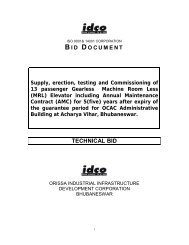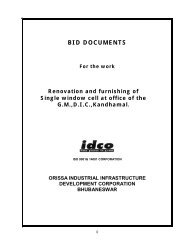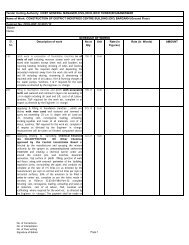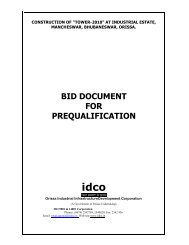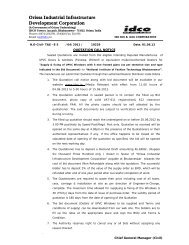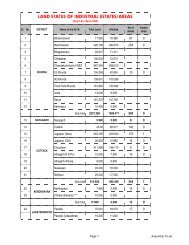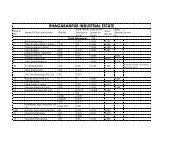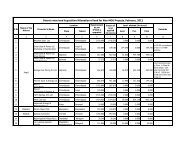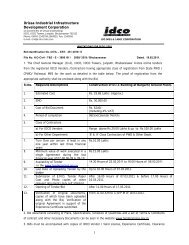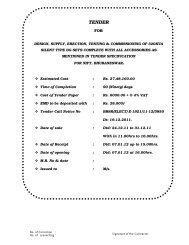BID DOCUMENT - IDCO
BID DOCUMENT - IDCO
BID DOCUMENT - IDCO
You also want an ePaper? Increase the reach of your titles
YUMPU automatically turns print PDFs into web optimized ePapers that Google loves.
(c) Where it is necessary to maintain two layers reinforcement at the correct distance apart Steel riders bent from<br />
12mm diameter mild steel bars shall be used.<br />
1.16.1 SPLICING AND WELDING OG REINFORCEMENT<br />
Welding of reinforcement will be permitted only where shown on the drawings. The welding shall be by<br />
electric and shall be performed by a skilled operator approved by engineer. The surface of the bars shall be<br />
thoroughly cleaned and scrubbed with brush immediately before welding and weld must be deposited<br />
evenly and all along shall be of even contour without cavities as per drawing or instruction of the Engineer.<br />
1.16.2 COVERING OF REINFORCEMENT<br />
(a)<br />
(b)<br />
(c)<br />
(d)<br />
(e)<br />
The reinforcement of footing and other principal structural members in which the concrete is deposited<br />
against the ground shall have not less than 75mm of concrete between it and the ground contract surface.<br />
If concrete surface after removal of the forms are to be exposed to the weather or to be in contract with the<br />
ground the reinforcement shall be protected with not less than 50mm concrete.<br />
The concrete protective covering for any reinforcement at surface not exposed directly to the ground or<br />
weather shall be not less than 25mm for slabs and walls and not less than 50mm for beams and girders.<br />
Column spirals or ties shall be protected everywhere by a covering of concrete cast monolithically with the<br />
core for which the thickness shall be not less than 50mm.<br />
Greater thickness of concrete covering if specified shall be kept as per drawings and direction of the<br />
engineer.<br />
Exposed reinforcing bars intended for binding with future extensions shall be protected from corrosion by<br />
concrete or other adequate covering.<br />
1.16.3 CONSTRUCTION JOINTS<br />
(a)<br />
(b)<br />
Concrete should be deposited continuously and as rapidly as practicable until the unit of operation<br />
approved by the engineer in charge in completed where construction joints are from the beams or slabs and<br />
not ever the support.<br />
As per drawing or as per engineer approval joints not indicated on the plans shall be so made and located<br />
as not to impair significantly the strength of the structure. Where a joint is to be made the surface of the<br />
concrete shall be thoroughly cleaned and all Latinate removed. In addition to the forgoing virtual joints shall<br />
be thoroughly seated and slashed with a coat of neat cement grout immediately before placing of new<br />
concrete.<br />
A delay must occur at least until the concrete in columns or walls is no longer plastic before casting of<br />
concrete in beams girders brackets columns capitals and haunches shall considered as part of the floor<br />
system and shall be placed monolithically therewith.<br />
1.16.4 DAY’S WORK JOINTS<br />
(a)<br />
(b)<br />
(c)<br />
(d)<br />
No fresh concrete shall be placed against any concrete which has attained its initial set. Concrete is<br />
deemed to have attained its initial set 30 minutes after water has been added to the mix. Provided that the<br />
set concrete has been properly placed and compacted and is acceptable to the engineer it shall not be<br />
disturbed. It shall be allowed to attain its final set and to harden sufficiently to enable a day’s work joint<br />
surface on it to be prepared by through hacking without damage. Concrete may be deemed to have<br />
hardened sufficiently for this purpose 72 hrs after placing.<br />
Any concrete, which has been disturbed after it has attained initial set, shall be rejected and subsequently<br />
removed by the contractor at his own expenses.<br />
When concreting must be suspended at any paint because of weather or for any other cause a day’s work<br />
joint shall be made.<br />
The concrete at day’s work shall be allowed to harden for 72 hrs. Before fresh concrete is placed against<br />
the day’s work joint all those and imperfect materials, cement scum or Latinate shall be removed from the<br />
joint surface which shall be thoroughly hacked until a completely hacked, roughened, fresh surface is<br />
obtained. The fresh surface shall then be brushed clean and immediately before fresh concrete is placed<br />
against it shall be thoroughly whetted and covered with a layer of 1:1.5 cement and sand mortar not less<br />
than 38mm thick. The mortar shall have the consistency of condensed milk.<br />
30



